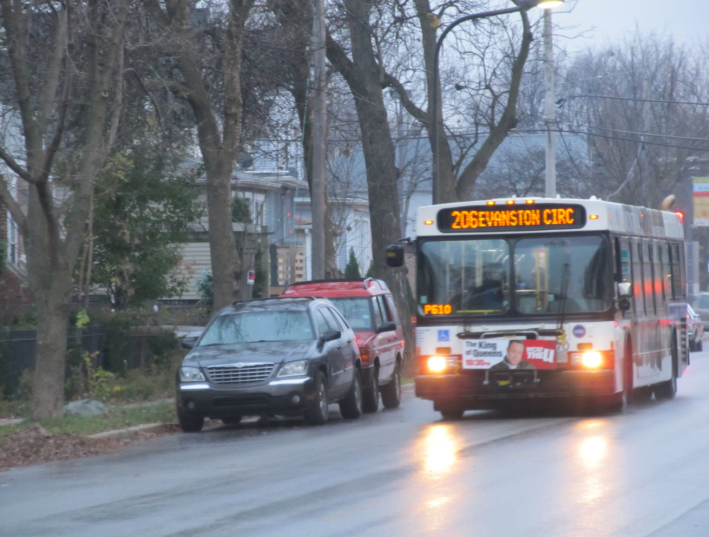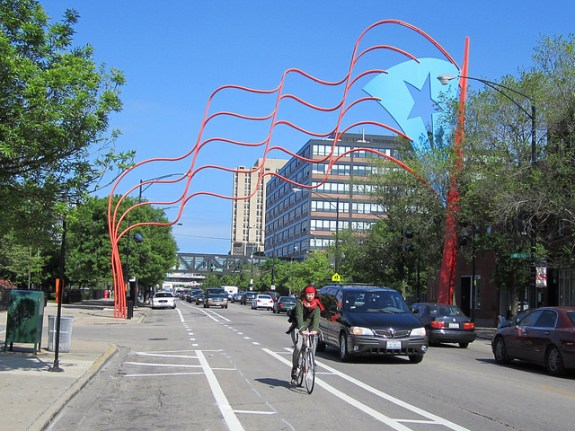A recent study titled “Where does active travel fit within local community narratives of mobility, space, and place?” published in the journal Transportation Research Part A investigates the promotion of walking and biking in two different communities through focus groups in Chicago’s Humboldt Park, a historically Puerto Rican neighborhood, and the suburb of Evanston, a racially diverse but majority-white suburb. Amanda Stathopoulos, assistant professor of civil and environmental engineering at Northwestern University, led the study.
Authors included Alec Biehl, a PhD student in the Department of Civil and Environmental Engineering at Northwestern; David Uttal, professor of psychology at Northwestern; Northwestern alumna Karla Sanabria-Véaz of the University of Puerto Rico; and Ying Chen, research assistant professor in the Northwestern University Transportation Center.
The research centers on analysis of the verbal transcripts from the focus groups, and the aim of the analysis was to uncover local mobility culture, embedded norms and values associated with acceptance of active transportation in the two communities.
Researchers conducted a total of five focus group sessions, three in Humboldt Park in July 2016 and two in Evanston in September 2016. Two of the focus groups in Humboldt Park were held at the Puerto Rican Cultural Center and one was held at the Humboldt Park Empowerment Center. One of the focus groups in Evanston was held at the Evanston Civic Center and the second was held in Northwestern University’s Chamber Hall. These locations were primarily chosen for their accessibility to focus group participants.
Humboldt Park participants either held a leadership role in the Puerto Rican Cultural Center, or were an employee of a business or organization located along the Paseo Boricua business strip on Division Street. All participants were Hispanic and 18 or older. Evanston focus groups consisted of bike shop owners, local professionals, and members of government-sponsored task forces interested in transportation, and were middle-aged or elderly white individuals.
The study provided context to both neighborhoods and how discourse around transit takes shape. For example, the study noted that Humboldt Park residents may not altogether oppose cycling infrastructure, but it’s association with so-called hipsters and yuppies, as well as white males, may be a hindrance to its expansion.
An important point made in the article, which is fundamental to understanding Humboldt Park, is that residents of the neighborhood are fierce defenders of their space. This is evdenced by symbolism and art visible in the community portraying the Puerto Rican heritage. This autonomy, according to the study, creates a keen awareness of the conflict of “shared space” from different mobility cultures.
Many participants from Humboldt Park did have positive things to say about transportation in the area, particularly compared to Puerto Rico. They mentioned frequent CTA bus service and the ease of navigating the network.
The Humboldt Park participants generally agreed that more walking and biking is good for society. However, they mentioned barriers to their own participation, such as concern about personal safety. They noted that the neighborhood has dangerous intersections, the bike lanes are located next to car doors, and there isn't a cohesive network of bikeways.
Another barrier to embracing biking is the perception of it being a leisure activity, rather than a practical way to get around. Improving public transportation was seen as more of a priority, especially since the majority of jobs and amenities are located outside the neighborhood, which also raises the question of access to resources. The study also noted that cycling is still not seen as a utilitarian activity within Latino households, though there is a growing bike community in the neighborhood.
The report also made a relevant point about barriers to the widespread adoption of ride-share services like Uber and Lyft in Humboldt Park. These include longer wait times for pick-ups due to limited driver interest in the area, and need to have a smartphone and a credit card in order to use the service.
Issues of gentrification and displacement also inform Humboldt Park residents' perceptions of new transportation amenities like Divvy bike-share stations. Some said said the expansion of transportation access in the neighborhood seemed to be about attracting new residents rather than serving current ones.

While Evanston is a different kind of community than Humboldt Park, it also has transportation equity issues. One Evanston resident mentioned that some of the suburb's lower-income neighborhoods have historically lacked good east-west transit service, which makes it harder to access the lakefront. Another study participant noted that these communities have been somewhat excluded from conversations about multi-modal transportation.
One conflict that came up is the tension between users of different modes as street space is renegotiated among mobility cultures. The desire for more frequent bus service can be at conflict with cycling as the street may not be able to always accommodate both bus stops and protected bike lanes. The study pointed out several of these conflicting interactions between different mobility users.
Among Evanston residents, there was also a concern about after-school programs being difficult to access using public or private transportation. One participant hoped that schools and activity centers can coordinate to expose students to a lifestyle that is not heavily car-dependent.
An interesting point made by one participant was the potential for Evanston to have some of the positive qualities of upscale, transit-friendly Chicago neighborhoods, but also maintain socioeconomic diversity. One participant said, “We can be Lincoln Park north in terms of really great restaurants, really good shopping, really good transportation so that you can live here without having to necessarily have a car.” Another also noted that, because of its high housing costs, Lincoln Park is much less diverse than Evanston.
The study noted that participants from both Humboldt Park and Evanston pointed out the potential for conflicts when different types of road users have to share street space. This brought up issues of how bike lanes, bus lanes, and vehicular parking interact. Participants also generally agreed that investment in public transit should be a priority.
An interesting contrast that the study revealed was that Evanston participants typically pointed out what their community possessed compared to others, while Humboldt Park residents were more likely to talk about what their neighborhood lacks.
Humboldt Park and Evanston residents also had contrasting perceptions of bus service. In Humboldt Park the bus is considered a useful amenity, but in Evanston, the bus is often associated with low social status.
In terms of cycling, Evanston residents tended to view transportation cyclists as being somewhat elitist, while Humboldt Park residents tended to dismiss cycling due to its association with leisure.
Both Humboldt Park and Evanston residents view active transportation as having benefits. But the local contexts influence how residents view different modes, so decision-makers should take these factors into account when shaping transportation policies.





